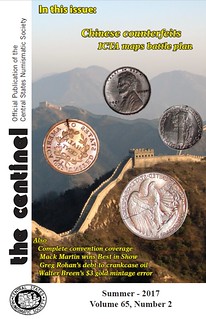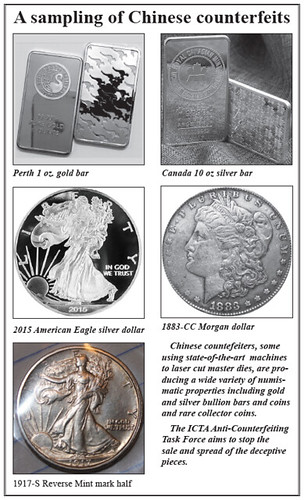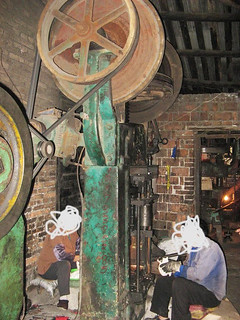
PREV ARTICLE
NEXT ARTICLE
FULL ISSUE
PREV FULL ISSUE
HOBBY GROUP ATTACKS CHINESE COUNTERFEITINGLen Augsburger pointed me to an article in the Summer 2017 issue of The Centinel, the official publication of the Central States Numismatic Society. The article by Beth
Deisher addresses the problem of Chinese counterfeits of collectible numismatic items, and the efforts of the Industry Council for Tangible Assets (ICTA) to combat it. Thank to The Centinel
editor Gerry Tebben for providing the text and images. -Editor
Counterfeiters have been plying their trade for thousands of years. The evidence lies in the contemporary counterfeits of ancient coins dug from the earth and documentation since the invention of the printing press. Yet, throughout the centuries counterfeiters produced a relatively small number of coins in comparison to the number of real coins struck. It was simply a matter of talent and resources. It took artistic talent to hand-carve dies and humans to hammer-strike the coins. The technology leap ushered in by invention of the steam-powered coin press in 1833 and the United States Mint’s introduction of the French portrait lathe in its die-making process in 1836 elevated coin manufacturing to a new level. Counterfeiters rarely had access to the die-making equipment or production presses necessary for large-scale counterfeit coin production. Fast-forward to the beginning of the 21st century. During the first five years of the new century most government mints around the world began embracing computer technology and robotics in their die-making and coin production processes. It was not a matter of simply installing and adapting modern manufacturing methods. Rather, competition – especially in the commemorative coin sector – demanded cost-effective manufacturing and innovative features in design and metallurgy. The U.S. Mint, content to produce its two lowest circulating denomination coins at a loss, was directed by Congress to look for lower cost alloys for the cent and 5-cent coins. Also, increasingly innovative commemorative coins on the world stage led to questions of why the United States could not produce equally interesting and visually attractive coins. The search for both efficiency and innovation led to the U.S. Mint’s transition in 2008 to digital technology in its die-making operation, producing both never-before experienced efficiencies and precision. During the same period, the Mint moved to increase use of computer-controlled processes and robotics throughout its manufacturing and packaging operations. Ironically, rather than making counterfeiting more difficult, the transition to computers and digital technology has opened new doors of opportunity for counterfeits. That is primarily due to rapid leaps in technology and knowledge of how to use it that have spread throughout the world at unprecedented levels in human history. The same is true for the accessibility to computer hardware and production equipment used in the various stages of coin production. Costs and availability are no longer a barrier to entry. For example, software programs used by designers and engravers at government mints are commercially available and easily acquired. Computer-savvy operators can bypass years of training and experience by simply scanning high-resolution digital images and manipulating them to produce the desired product. Equipment to laser cut master dies can be purchased at manufacturer trade shows. The same is true for each step of the coining process, from blanking, to burnishing, to metal-plating, to producing the finished coin.
Coin World joined the New York Times in a year-long investigation, resulting in Coin World’s publication of a series in December 2008 that revealed more than 100 thriving coin counterfeiting operations in China. Most were small, cottage type operations. The largest, owned by a 26-year-old entrepreneur, relied on vintage 1870s U.S. coin presses salvaged from “scrap metal” sold by the Chinese government. (The U.S. government in the 1920s sold old coining presses to China, which after using them for years recently sold them as scrap metal.) The proprietor of the largest coin counterfeiting operation in China claimed in 2008 that he had the capacity to produce 100,000 coins a month, most of which were older Chinese coin types and sold in China. However, he was expanding a new line of counterfeit U.S. coins and selling about 1,000 per month in the United States via eBay. His business plan called for locating and establishing “wholesale” buyers in the U.S. who would buy in bulk and help him to identify the most popular sellers. Most of his “replica” coins could be identified because he used iron-based planchets plated with silver or with the proper alloy to match the authentic coin. He accepted orders for 90 percent silver and gold counterfeits, but his prices reflected the higher quality planchets. They constituted a very small portion of his business.
A prime factor in the accelerating growth of Chinese coin counterfeiters is their ability to market their wares worldwide via Alibaba, the e-commerce company that in 1999 entered the marketplace to connect Chinese manufacturers with overseas buyers. In April 2016 Alibaba.com became the world’s largest retailer and one of the largest internet companies, reaching into 200 countries. Leaders from throughout the numismatic community in the United States, recognizing the danger and urgency of the threat posed by the growing numbers of counterfeit coins entering the marketplace, came together in January 2017 to create the Anti-Counterfeiting Task Force (ACTF) under the authority of the Industry Council for Tangible Assets. To tackle the seemingly overwhelming situation, the ACTF has determined that its top priority must be to educate law enforcement authorities and policy makers about the rising threat of counterfeiting. Simultaneously, it seeks to mobilize law enforcement to attack counterfeiters where they are most vulnerable. Equally important, the ACTF has committed to assisting law enforcement with expertise and other resources in the investigation and prosecution of counterfeiters and those involved at all levels of their distribution networks. ACTF’s mission and programs support all who work in and who earn their livings from businesses related to the numismatic, bullion, and circulating coins. Equally important is protecting collectors and investors who fall victim to counterfeiters. Above all, ACTF seeks to ensure that decades of consumer confidence are not eroded by the increasing threat posed by the counterfeiters. ACTF is funded entirely through donations. It is seeking to raise at least $500,000 to sustain the task force’s work for the next two years. Donations can be made payable to ICTA – Anti-Counterfeiting and mailed to David Crenshaw, P. O. Box 237 Dacula, GA 30019 or paid online at ictaonline.org\donate-to-icta About the Author
Please consider making a donation to aid the ICTA effort. -Editor
To donate, click the DONATE button on this page:
Wayne Homren, Editor The Numismatic Bibliomania Society is a non-profit organization promoting numismatic literature. See our web site at coinbooks.org. To submit items for publication in The E-Sylum, write to the Editor at this address: whomren@gmail.com To subscribe go to: https://my.binhost.com/lists/listinfo/esylum All Rights Reserved. NBS Home Page Contact the NBS webmaster 
|


